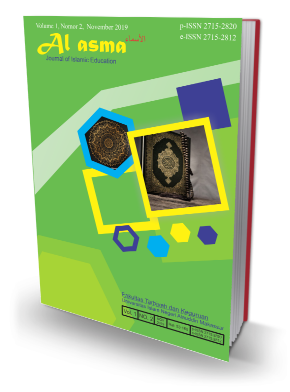EFEKTIVITAS PENERAPAN PICTURE EXCHANGE COMMUNICATION SYSTEM (PECS) TERHADAP KEMAMPUAN BERBICARA EKSPRESIF PADA ANAK DOWN SYNDROME
Abstract
Abstrak
Kemampuan berbicara ekspresif anak down syndrome sangat terbatas karena komunikasi nonverbal yang terlalu aktif. Picture Exchange Communication System (PECS) merupakan salah satu metode yang dapat digunakan untuk membantu meningkatkan kemampuan berbicara ekspresif. Penelitian ini bertujuan untuk mengetahui efektivitas penggunaan penerapan Picture Exchange Communication System (PECS) terhadap kemampuan berbicara ekspresif anak down syndrome. Partisipan dalam penelitian ini berjumlah satu orang anak down syndrome dengan karakteristik memiliki usia 7-12 tahun, dan kemampuan menyebutkan kosa kata di bawah lima. Penelitian ini menggunakan single-case experimental design pola A-B-A dengan teknik pengumpulan data observasi dan dokumentasi. Teknik analisis data menggunakan analisis deskriptif kualitatif dan uji hipotesis dilakukan dengan membandingkan hasil pretest dan posttest. Hasil uji hipotesis menunjukkan bahwa penerapan Pictute Exchange Communication System (PECS) efektif meningkatkan kemampuan berbicara ekspresif responden, yaitu bertambah enam jumlah kosakata yang mampu diucapkan setelah 17 kali diberikan PECS. Penelitian ini menjadi alternatif bagi orang tua dan guru dalam meningkatkan kemampuan berbicara ekspresif dengan menggunakan PECS dalam kehidupan sehari-hari.
Abstract
The ability to speak expressively down syndrome children is very limited due to overactive nonverbal communication. Picture Exchange Communication System (PECS) is one of the methods that can be used to help improve expressive speech skills. This study aims to determine the effectiveness of the use of Picture Exchange Communication System (PECS) on the expressive speech ability of down syndrome children. Participants in this study numbered one down syndrome child with characteristics aged 7-12 years, and the ability to mention vocabulary under five. This study used a single case experimental design with A-B-A pattern with observation and documentation data techniques. The data analysis technique used qualitative descriptive analysis and hypothesis testing was done by comparing the results of the pretest and posttest. Hypothetical test results showed that the application of Picture Exchange Communication System (PECS) effectively improved the respondent's expressive speech ability, which increased the number of vocabulary that was able to be spoken after 17 times given by PECS. This study is an alternative for parents and teachers in improving expressive speaking skills by using PECS in daily activity.
Downloads
References
Barbosa, R. T. de A., de Oliveira, A. S. B., de Lima Antão, J. Y. F., Crocetta, T. B., Guarnieri, R., Antunes, T. P. C., … de Abreu, L. C. (2018). Augmentative and alternative communication in children with down’s syndrome: A systematic review. BMC Pediatrics, 18(1), 1–16. https://doi.org/10.1186/s12887-018-1144-5.
Creswell, J. W. (2014). Research design: qualitative, quantitative, and mixed methods approaches. California: SAGE Publication.
Hart, S. L., & Banda, D. R. (2010). Picture exchange communication system with individuals with developmental disabilities: A meta-analysis of single subject studies. Remedial and Special Education, 31(6), 476–488. https://doi.org/10.1177/0741932509338354.
Heryati, E., & Ratnengsih, E. (2017). Penggunaan metode PECS (Picture Exchange Communication System) untuk meningkatkan kemampuan komunikasi anak autis. Pedagogia: Jurnal Ilmu Pendidikan, 15(1), 30. https://doi.org/10.17509/pedagogia.v15i1.6558
Hurlock. (2008). Psikologi perkembangan. Jakarta: Erlangga Press.
Indah, R. N. (2017). Gangguan berbahasa kajian pengantar. Malang: UIN MALIKI Press.
Irwanto, Wicaksono, H., Ariefa, A., & Samosir, A. M. (2019). A-Z sindrom down. Surabaya: Airlangga University Press.
Kumin, L. I. K. (2003). Starting out: speech and language intervention for infants and toddlers with down syndrome. Down Syndrome. In Down Syndrome (pp. 393–406). https://doi.org/10.1002/0471227579.ch29
Latipun. (2008). Psikologi eksperimen. Malang: UMM Press.
Marder, L., & Ní Cholmáin, C. (2006). Promoting language development for children with Down’s syndrome. Current Paediatrics, 16(7), 495–500. https://doi.org/10.1016/j.cupe.2006.08.022
Mukhtar. (2013). Metode praktis penelitian deskriptif kualitatif. Jakarta Selatan: GP Press Group.
Preston, D., & Carter, M. (2009). A review of the efficacy of the picture exchange communication system intervention. Journal of Autism and Developmental Disorders, 39(10), 1471–1486. https://doi.org/10.1007/s10803-009-0763-y
Rosalina, D. (2017). Pengaruh metode PECS (Picture Exchange Communication System) terhadap komunikasi nonverbal peserta didik autis di slbn pembina provinsi sulawesi selatan. Universitas Negeri Makassar.
Seniati, L., Yulianto, A., & Setiabudi, B. (2015). Psikologi eksperimen. Jakarta: PT Indeks.
Suchowierska, M., Rupińska, M., & Bondy, A. (2013). Picture Exchange Communication System ( PECS ): A short “ tutorial ” for the doctors. Postępy Nauk Medycznych, xxvi(1), 85–90.
Sugiyono. (2016). Metode penelitian pendidikan (pendekatan kuantitatif, kualitatif dan R&D). Alfabeta.
Sunanto, J., Takeuchi, K., & Nakata, H. (2005). Pengantar penelitian dengan subjek tunggal. Japan: Center of Research on International Cooperation in Educational Development (CRICED) University of Tsukuba.
Vistasari, R., & Patria, B. (2019). Program PECS (Picture Exchange Communication System) untuk meningkatkan kemampuan berbicara terstruktur pada anak autis. Gadjah Mada Journal of Professional Psychology (GamaJPP), 5(1), 94. https://doi.org/10.22146/gamajpp.48590.
Wardah. (2019). Antara fakta dan harapan sindrom down. Jakarta: Kementrian Kesehatan RI Pusat data dan Infomasi.
- Authors retain copyright and grant the journal right of first publication with the work simultaneously licensed under a Creative Commons Attribution License that allows others to share the work with an acknowledgement of the work's authorship and initial publication in this journal.
- Authors are able to enter into separate, additional contractual arrangements for the non-exclusive distribution of the journal's published version of the work (e.g., post it to an institutional repository or publish it in a book), with an acknowledgement of its initial publication in this journal.
- Authors are permitted and encouraged to post their work online (e.g., in institutional repositories or on their website) prior to and during the submission process, as it can lead to productive exchanges, as well as earlier and greater citation of published work (See The Effect of Open Access).

